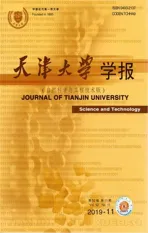地下防护工程空调相变储热水池储热性能实验研究
2019-08-05张洪宇庄春龙黄光勤刘亚姣
张洪宇,卢 军,庄春龙,黄光勤,余 杰,刘亚姣
地下防护工程空调相变储热水池储热性能实验研究
张洪宇1,卢 军2,庄春龙1,黄光勤1,余 杰1,刘亚姣1
(1. 陆军勤务学院军事设施系,重庆 401311;2. 重庆大学城市建设与环境工程学院,重庆 400044)
针对既有地下防护工程传统空调冷却水池储热能力不足,外置冷却塔易造成工程红外暴露而影响工程安全的问题,提出了采用空调相变冷却水池方案以期增强系统储热能力,延长工程隔绝防护条件下空调系统运行保障时间.搭建了地下防护工程空调相变储热水池实验台,研究了定负荷条件下相变储热单元用量、冷却水流量对相变储热水池储热性能的影响;考虑添加相变储热单元对水池储热能力与连续保障能力的影响,提出了地下防护工程空调相变储热水池储热性能评价指标:相变储热水池单位体积储热量和基于出口温度定义的相变储热水池保障效能系数.研究表明:向地下防护工程空调储热水池中加入相变单元能够提升空调储热水池储热能力;与未加入相变储热单元的空调储热水池相比,当相变储热单元体积占空调储热水池有效容积的2.84%、4.26%时,相变储热水池单位体积储热量分别提高了6.35%和9.03%,相变储热水池保障效能系数分别提高了7%和11%,空调系统运行保障时间分别延长了1.77h和2.82h;在实验条件下,流速从250L/h提高至450L/h时,水池单位体积储热量和保障效能系数均有所降低,大流量工况(450L/h)下,相变储热单元存在未完全融化,水池储热能力与连续保障能力明显降低,因此在不影响热泵机组正常运行和水池储热性能的情况下,适当降低冷却水流量对空调储热水池储热系统是有益的.
地下防护工程;空调冷却水池;相变材料;相变储热
地下防护工程能正常运转,要求工程内部空气的温湿度必须保持在一定范围内,而这正是通过通风空调系统实现的.随着电子设备的骤然增多,地下防护工程中余热急剧增加[1],导致工程处于隔绝防护状态时,原有空调冷却水池所能维持空调系统的运行时间大大降低,而扩建空调冷却水池施工困难,加设冷却塔易造成工程红外暴露.
为解决传统地下防护工程空调冷凝热处理模式不足,学者们从增强工程隐蔽效果、冷凝热处理模式转换等方面做了大量工作.周涤生等[2]和冯爽[3]采用冷却塔入地方案,应用于上海外滩观光隧道工程.王晋生等[4-5]和刘文杰等[6]提出防护工程非定型冷却塔的设计理论,将冷却塔置于地下空调冷却水池上方,利用水池的水蒸发和柴油电站进排风带走热量,设计方案应用在了上海某国防工程.何叶从等[7]研发了一种旋转喷雾间接蒸发冷却器,可安装于地下建筑排风通道内.耿世彬等[8]采用地下储水箱和风冷热泵机组联合的方式来替代冷却塔.上述方案有的仅减少了红外暴露点,有的对使用地点及工程内负荷分配要求较高.相变材料作为储能的良好介质,如选择合适的相变材料应用于地下防护工程空调冷却水池,在不增加水池容积的基础上,可增加水体热容量,延长空调系统运行时间.基于此,本文提出在空调冷却水池中加入相变储热单元构成空调相变冷却水池,利用相变储能技术解决既有空调冷却水池储热量不足的问题.
1 空调相变冷却水池储热实验系统及实验方案
1.1 实验系统
为分析空调相变冷却水池运行特性,搭建了空调相变冷却水池储热实验台.系统示意如图1所示,实验台实物图如图2所示.实验设备及主要仪器包括:管道加热器、相变水池、相变储热单元、循环水泵、浮子流量计、管路部件以及T型热电偶模块、温度采集仪等.

图1 空调相变冷却水池储热实验系统示意
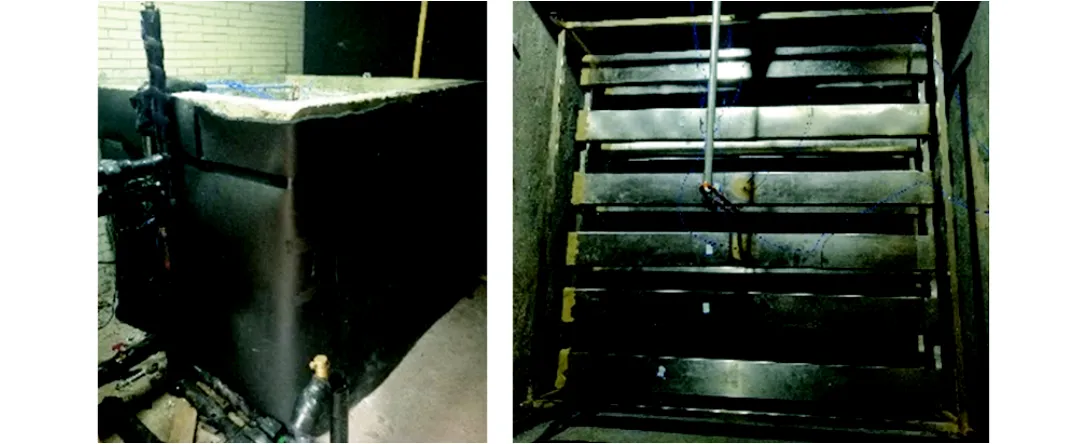
(a)水池外观 (b)相变单元布置
管道加热器额定功率2kW,水池规格(长×宽×高)为1.3m×1.3m×1.2m,有效容积1.86m3,进出口分别位于水池上下中心处.循环水泵为德国威乐管道泵,额定扬程5m,额定流量13L/min.浮子流量计量程60~600L/h,精度为±2.5%.循环管道采用DN20镀锌钢管,为减少实验过程热损失,循环管道及水池四面用15mm厚橡塑保温棉做保温处理.热电偶精度为±0.1℃,温度采集频率为1次/min.1#、8#热电偶分别监测水池入口、出口温度,实验测点及相变储热单元布置见实验方案.
传统的相变储热装置一般只采用一种相变材料,已有研究表明,储热过程中储热装置内会出现温度分层[9-11],严重时会出现靠近入口处相变材料已经完全相变并迅速升温,而远离入口处相变材料还未完成相变的不利情况.本文提出一种地下防护工程多熔点空调相变储热水池概念,即在地下防护工程空调冷却水池中采用具有不同熔点的多种相变材料代替单一相变材料,根据熔点高低合理安排其排放位置,最大限度地利用相变潜热储热,提高相变潜热有效利用率.选用2种石蜡相变材料分别填充相变单元,其主要物性参数见表1.
表1 PCM-1和PCM-2相变石蜡的主要物性参数

Tab.1 Main physical parameters of the PCM-1 and PCM-2 phase change paraffin
考虑到相变材料对封装材料的腐蚀性[12]以及封装材料应具有较高的导热系数,选用304不锈钢进行封装,封装尺寸为1.1m×0.1m×0.03m.
1.2 实验方案
通过阀门开度的调节改变进入储热水池的流量,研究冷却水流量对空调储热水池流场及储热性能的影响,流量主要包括3种情况:250L/h、350L/h、450L/h.此外,通过调整相变单元的数量,研究相变储热单元用量对储热水池储热性能的影响,相变单元用量主要包括16个和24个两种情况.实验过程中,为了研究储热水池内部水体温度分布情况,沿水池竖向高度布置2#~7#共6个热电偶,热电偶竖向间距19cm.同时,为了观测相变材料在储热过程中的温度变化特性,在每层中间位置相变储热单元内部布置1#~4#共4个相变温度测点,测点分别布置在4个相变单元的中心位置.相变单元及温度测点具体布置方案见图3.
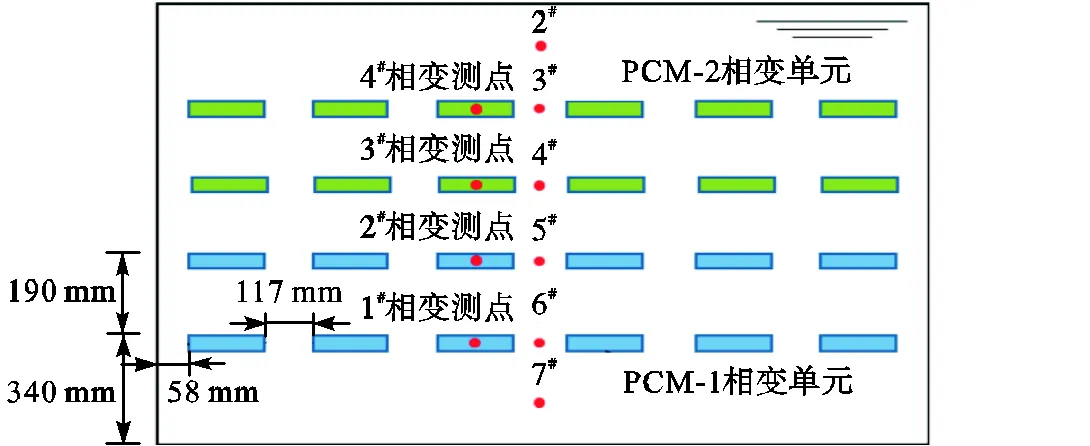
(a)24个相变单元
(b)16个相变单元
图3 相变储热单元及测点布置
Fig.3 Phase change heat storage unit and measuring point layout
2 相变储热水池性能评价指标
国内外学者对相变储热装置的传热特性进行了大量研究[13-15],并且有一些学者提出了相应的评价指标[16-17].但对于应用于地下防护工程空调冷却水池的评价指标较少,本文依据相变储热水池的预期目标效益,提出两种指标对空调相变水池的储热性能进行定义和研究.
2.1 相变储热水池单位体积储热量
相变水池所能储存的热量是评价其储热能力的一个重要指标,对水池设计容量的确定具有重要指导意义.当冷却水流速不变时,其计算方法为

为了更加科学指导相变水池的设计,定义相变储热水池单位体积储热量作为相变储热水池储热能力评价指标之一,其计算式为

2.2 基于出口温度定义的相变储热水池保障效能系数



3 实验结果及分析
3.1 未加入相变储热单元空调储热水池储热性能实验
作为添加相变储热单元储热效果的对比依据,本文实验研究了未加入相变储热单元的空调冷却水池储热性能.图4为未加入相变储热单元空调储热水池出入口温度变化情况.


图4 未加入相变储热单元空调储热水池进出口温度变化
3.2 相变储热单元用量对空调相变储热水池储热性能的影响
为了研究不同相变储热单元用量对空调相变储热水池储热性能的影响,开展了2种不同相变单元数量的储热实验:16个相变单元、24个相变单元.其中16个相变单元的相变材料填充量为PCM-1、PCM-2各22kg;24个相变单元的相变材料填充量为PCM-1、PCM-2各33kg.

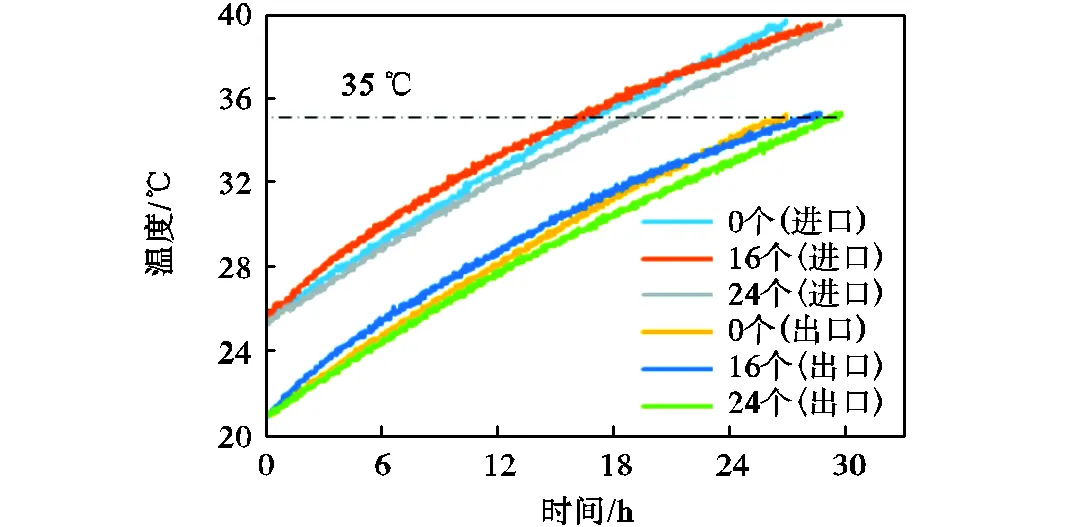
图5 不同数量相变储热单元下空调储热水池进出口温度变化
表2为不同相变储热单元数量下储热水池性能分析情况.

表2 不同相变储热单元数量下空调储热水池性能

Tab.2 Performance of air-conditioning reservoir under different quantities of phase change heat storage units
3.3 冷却水流量对空调相变储热水池储热性能的影响
在水池加热功率基本不变的情况下,水池进口流量与进口温度为一对耦合变量,提高流量则进口温度降低,降低流量则进口温度提高,与大部分现有地下防护工程空调系统运行时负荷基本为定值的情况较一致.
图6为空调相变储热水池在不同进口流量下的进出口温度变化情况,图7为空调相变储热水池在不同进口流量下的进出口平均温度变化情况.

图6 不同进口流量下的进出口温度
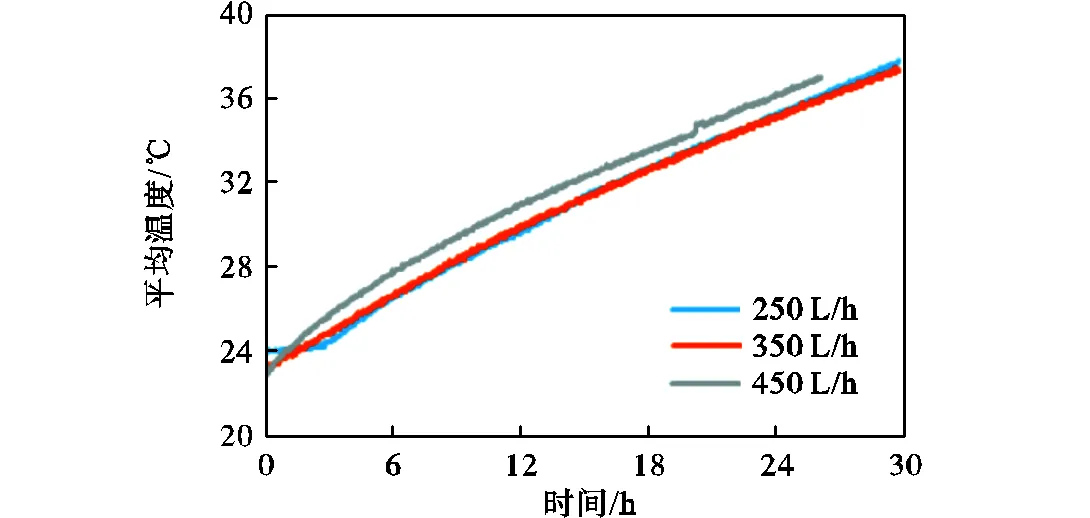
图7 不同进口流量下的进出口平均温度

由图6还可以看出,冷却水流量为250L/h时,在储热开始的前2.76h,进出口温度几乎没有变化,主要原因在于由于冷却水的流量较小,温度从上向下扩散需要较长时间,这段时间进入空调储热水池的冷凝热主要由上部水体储存.通过分析2#~7#热电偶监测温度可知相变储热水池竖向温度分布情况,流量为250L/h时水温的分层现象比较明显(见图9(a)).主要原因在于流量较小,冷却水进出口温差较大.竖向温度梯度较大.当冷却水流量增大到350L/h、450L/h时,冷却水进出口温差减少,空调储热水池中对流作用增强,热扩散迅速,竖向温度分布较均匀,分层现象较小流量时明显减弱(见图9(b)、(c)).

图8 流量为450L/h时相变储热单元内部温度变化
表3为变流量实验工况下相变储热水池储热性能分析统计.

可见,在既有空调储热水池中加入相变储热单元,在储热过程中当相变储热单元完全相变情况下,改变进口流量对相变储热水池储热性能影响微弱.在实际应用中,如增加冷却水流量即提高流速,则泵需要消耗更多的功,储热过程能量损耗提高,因此在不影响热泵机组正常运行和水池储热性能的情况下,适当降低流量对储热系统是有益的.
表3 变流量实验工况下相变储热水池储热性能

Tab.3 Thermal storage performance of the phase change heat storage resevoir under variable flow experimental conditions

(a)250 L/h
(b)350 L/h
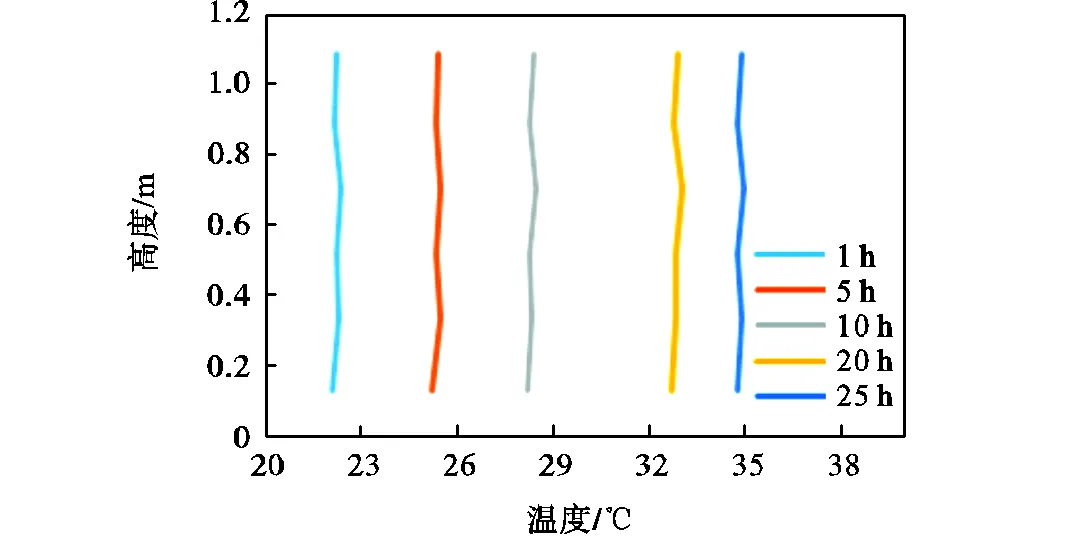
(c)450 L/h
4 结 论
本文对地下防护工程空调相变储热水池储热性能进行了实验研究,提出了相变储热水池单位体积储热量和基于出口温度定义的相变储热水池保障效能系数,分析了相变单元用量和冷却水流速对相变水池储热能力的影响,主要得到如下结论.

(2) 在实验条件下,流速从250L/h提高至450L/h时,水池单位体积储热量和保障效能系数均有所降低,大流量工况(450L/h)下,相变储热单元存在未完全融化情况,水池储热能力与连续保障能力明显降低.
[1] 訾冬毅,缪小平,刘文杰. 蒸发式冷凝器在地下工程中的应用[J]. 制冷与空调,2009,9(3):36-40.
Zi Dongyi,Liao Xiaoping,Liu Wenjie. Application of evaporative condenser into underground project[J]. Refrigeration and Air-Conditioning,2009,9(3):36-40(in Chinese).
[2] 周涤生,李祥麟. 地下冷却塔在外滩观光隧道中的应用[J]. 上海建设科技,2002,93(3):20-21.
Zhou Disheng,Li Xianglin. Application of underground cooling tower in the Bund sightseeing tunnel[J]. Shanghai Construction Technology,2002,93(3):20-21(in Chinese).
[3] 冯 爽. 地下式冷却塔设计实例及其发展前景[J]. 地下工程与隧道,2004,18(14):46-52.
Feng Shuang. Design and development of underground cooling tower[J]. Underground Engineering and Tunnel,2004,18(14):46-52(in Chinese).
[4] 王晋生. 防护工程冷凝热处理过程作用机理及设计理论研究[D]. 南京:解放军理工大学,2009.
Wang Jinsheng. Study on Mechanism and Design Theory of Condensation Heat Treatment Process in Protective Engineering[D]. Nanjing:PLA University of Science and Technology,2009(in Chinese).
[5] 王晋生,刘文杰,蔡 浩,等. 地下蓄冷防护型冷却塔[J]. 制冷与空调(四川),2010,24(5):1-5.
Wang Jinsheng,Liu Wenjie,Cai Hao,et al. Underground thermal storage defensive cooling tower[J]. Refrigeration & Air Conditioning,2010,24(5):1-5(in Chinese).
[6] 刘文杰. 防护工程冷凝热处理模式及相关设备研究[D]. 南京:解放军理工大学,2009.
Liu Wenjie. Research on Condensation Heat Treatment Mode and Related Equipment of Protective Engineering[D]. Nanjing:PLA University of Science and Technology,2009(in Chinese).
[7] 何叶从,邹国荣,肖益民,等. 间接蒸发冷却用气-水雾化喷嘴特性器实验研究[J]. 重庆建筑大学学报,2008,30(6):105-109.
He Yecong,Zou Guorong,Xiao Yimin,et al. Spray characteristics of a two phase air-water nozzle for indirect evaporative cooling[J]. Journal of Chongqing Jianzhu University,2008,30(6):105-109(in Chinese).
[8] 耿世彬,李 永,韩 旭. 水环热泵空调系统在地下工程中的应用[J]. 解放军理工大学学报:自然科学版,2011,12(2):139-144.
Geng Shibin,Li Yong,Han Xu. Water loop heat pump system in underground engineering[J]. Journal of PLA University of Science and Technology:Natural Science Edition,2011,12(2):139-144(in Chinese).
[9] 于国清,汤金华,吕 静. 水-相变材料复合蓄热装置的温度分布模型研究[J]. 流体机械,2009,37(11):65-68.
Yu Guoqing,Tang Jinhua,Lü Jing. Research on temperature stratification model of water-PCM hybrid thermal storage[J]. Fluid Machinery,2009,37(11):65-68(in Chinese).
[10] 于国清,汤金华,赵慧忠. 水-相变材料复合蓄热装置的充放热特性研究[J]. 流体机械,2010,38(7):59-62.
Yu Guoqing,Tang Jinhua,Zhao Huizhong. Research on the thermal charge and discharge of water-PCM hybrid thermal storage[J]. Fluid Machinery,2010,38(7):59-62(in Chinese).
[11] 汤金华. 太阳能供热系统中水-相变材料复合蓄热研究[D]. 上海:上海理工大学,2008.
Tang Jinhua. Study on Composite Heat Storage of Water-Phase Change Materials in Solar Heating System[D]. Shanghai:Shanghai University of Technology,2008(in Chinese).
[12] 铁生年,柳 馨. 相变材料的腐蚀性与封装材料研究进展[J]. 材料导报,2016,29(6):138-143.
Tie Shengnian,Liu Xin. Research progress of corrosivity of phase change material and relevant packaging materials[J]. Material Guide,2016,29(6):138-143(in Chinese).
[13] Niyas H,Prasad S,Muthukumar P. Performance investigation of a lab-scale latent heat storage prototype-Numerical results[J]. Energy Conversion & Manage-ment,2017,135(3):188-199.
[14] Regin A F,Solanki S C,Saini J S. Heat transfer characteristics of thermal energy storage system using PCM capsules:A review[J]. Renewable & Sustainable Energy Reviews,2008,12(9):2438-2458.
[15] Zheng H,Wang C,Liu Q,et al. Thermal performance of copperfoam/paraffin composite phase change material[J]. Energy Conversion and Management,2018,157(2):372-381.
[16] Niyas H,Rao C R C,Muthukumar P. Performance investigation of a lab-scalelatent heat storage prototype-experimental results[J]. Solar Energy,2017,155 (10):971-984.
[17] Yang J,Yang L,Xu C,et al. Experimental study on enhancement of thermal energy storage with phase-change material[J]. Applied Energy,2016,169(5):164-176.
Performance of the Phase Change Heat Storage Air-Conditioning Reservoir for Underground Protective Engineering
Zhang Hongyu1,Lu Jun2,Zhuang Chunlong1,Huang Guangqin1,Yu Jie1,Liu Yajiao1
(1. Department of Military Facilities,Army Logistic University of PLA,Chongqing 401311,China;2. School of Urban Construction and Environmental Engineering,Chongqing University,Chongqing 400044,China)
Aiming for the insufficient thermal storage capability of the traditional air-conditioning reservoir and the problem of engineering safety caused by infrared exposure on the external cooling tower for existing underground protective engineering,the phase change storage reservoir scheme is proposed to strengthen the thermal storage capability and to prolong the run time of the HVAC system under the isolation protection condition. An experiment on the phase change heat storage air-conditioning reservoir was conducted,and the effects of the quantity of the phase change heat storage unit and the water mass flow on the capability of the reservoir are analyzed under the fixed load condition. To analyze the effects of the phase change heat storage unit on the heat storage capacity and continuous safeguarding capacity of the reservoir,the following performance parameters of the phase change heat storage reservoir for underground protective engineering are proposed:Heat storage capacity per unit volume and safeguarding efficiency of the phase change heat storage pool. The results show that adding the phase change heat storage unit can significantly improve the heat storage capacity of the reservoir. Compared with the reservoir without phase change heat storage unit,when the volume of the phase change heat storage unit accounts for 2.84% and 4.26% of the effective volume of the reservoir,the heat storage capacity per unit volume of the phase change heat storage reservoir is increased by 6.35% and 9.03%,the guaranteed efficiency coefficient of the phase change heat storage reservoir is increased by 7% and 11%,and the guaranteed operation time is prolonged by 1.77h and 2.82 h,respectively. Under the experimental conditions,when the flow rate is increased from 250 L/h to 450 L/h,the heat storage capacity per unit volume and guaranteed efficiency coefficient are both reduced. When the flow rate is high (450 L/h),the phase change heat storage units do not melt completely and the heat storage capacity and guaranteed continuous capacity of the pool are significantly reduced. Therefore,properly reducing the cooling water flow rate is beneficial to the heat storage system of the reservoir without affecting the operation of the heat pump unit and the heat storage performance of the reservoir.
underground protective engineering;air-conditioning reservoir;phase change material;phase change heat storage
TK02
A
0493-2137(2019)11-1187-07
10.11784/tdxbz201812004
2018-12-03;
2018-12-28.
张洪宇(1981— ),男,博士研究生,讲师,13883291029@163.com.
卢 军,lujun66@vip.sina.com.
国家重点研发计划资助项目(2017YFC0806305);国家自然科学基金资助项目(51706243).
Supported by the National Key Research and Development Program of China(No.2017YFC0806305),the National Natural Science Foundation of China(No.51706243).
(责任编辑:田 军)
